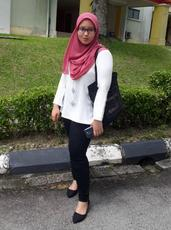Assalamualaikum and hi! 💻
Week : 5
Date : 18 July 2019 - 24 Aug 2019
Activities :
1. Third meeting with FYP2 Supervisor - Sir Shah Rizailli Mukhtar
📆 19 August 2019
⌚ 12.15 pm
📬 SPS 209
📌The components that have been bought were informed to the supervisor. Supervisor asks to configure the whole circuit connection for the hardware so that the collection of data can be taken earlier.
📌 Before starting the implementation of coding, some of the libraries need to be installed first or coding cannot be run due to missing the library. The first library that needs to be installed is the Arduino JSON. JSON is JavaScript Object Notation which is a lightweight data-interchange format that is easy for a programmer to read and write and easy for the machine to parse and generate. Without Arduino Json, string data type cannot be declared. Arduino JSON will help in the development of this project because by using this library, I can create mt own JSON data using data from the sound sensors that connected to the Arduino UNO and send data to Arduino WeMos through Wi-Fi connection. This is called as a serializing of JSON.
Arduino JSON library
*click to expand image*
📌 Other than Arduino JSON, a library of ESP8266 is needed to be installed for the transmitting and receiving of data via Wi-Fi connection, Without JSON and ESP8266 library, data cannot be transmitted and received through Wi-Fi connection. JSON library for the ESP8266 helps to parse the JSON data and extract the values based on the keys (string data type). Instead of just installed the ESP8266 library itself, I installed the BlynkESP8266 library because in the library it consists of ESP8266 library and Blynk library together. I can choose either I want to use only the ESP8266 library for the transmitting and receiving data or use it together with the Blynk library, so the output data of the transmitting and receiving will be sent automatically to the Blynk Apps.
BlynkESP8266 library
*click to expand image*
TelegramBot library
*click to expand image*
📆 21 August 2019
⌚ 3.00 pm - 5.00 pm
📬 TTL 2
📌 Speaker : Dr. Imran Mohd Sofi (IMS)
📌 Workshop on Results & Discussion (Chapter 4), Conclusion (Chapter 5) and Abstract in Thesis Writing.
📌 Workshop on Results & Discussion (Chapter 4), Conclusion (Chapter 5) and Abstract in Thesis Writing.
📌 FYP Hardcover Thesis report consists of 5 chapters.
📌 Chapter 4 is the results and discussions of the project. Technical abilities are reviewed in this chapter. A comparison of results with other journals must be put in the writing and explain why it is happening. All the results must be organised based on the objectives of the project. The results can be represented by figure, table, chart or drawing and clearly label. For the discussion, the trend of the results must be described here and explains why it happened. All the achievements of the objectives must be discussed clearly and informatively in this chapter.
📌 Chapter 5 is the conclusion of the project. Objectives are achieved must be stated in the conclusion and concluded this project is successful or not. In this chapter, the limitations, scopes and recommendations on the project also can be put here for the future improvement of the development of the project. The recommendation by the assessor during the FYP2 presentation also can be written in this chapter.
📌 An abstract is a summary of the project. Abstract needs to be written in a paragraph of one page (150 - 350 words only). Abstract consists of the scope of the project, the objectives, the results and the contents of the work briefly. An abstract is often used to help the reader quickly ascertain the thesis report's aim.
📌 Chapter 4 is the results and discussions of the project. Technical abilities are reviewed in this chapter. A comparison of results with other journals must be put in the writing and explain why it is happening. All the results must be organised based on the objectives of the project. The results can be represented by figure, table, chart or drawing and clearly label. For the discussion, the trend of the results must be described here and explains why it happened. All the achievements of the objectives must be discussed clearly and informatively in this chapter.
📌 Chapter 5 is the conclusion of the project. Objectives are achieved must be stated in the conclusion and concluded this project is successful or not. In this chapter, the limitations, scopes and recommendations on the project also can be put here for the future improvement of the development of the project. The recommendation by the assessor during the FYP2 presentation also can be written in this chapter.
📌 An abstract is a summary of the project. Abstract needs to be written in a paragraph of one page (150 - 350 words only). Abstract consists of the scope of the project, the objectives, the results and the contents of the work briefly. An abstract is often used to help the reader quickly ascertain the thesis report's aim.
"Tough times don't last. Tough people do."
Robert H. Schuller







 Week 4
Week 4


Post a Comment
<< home >>